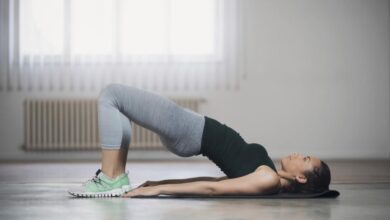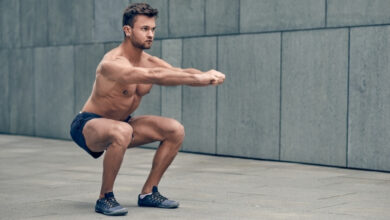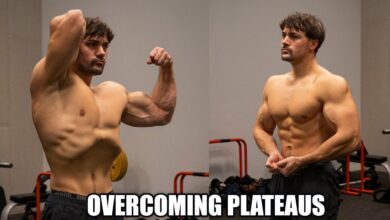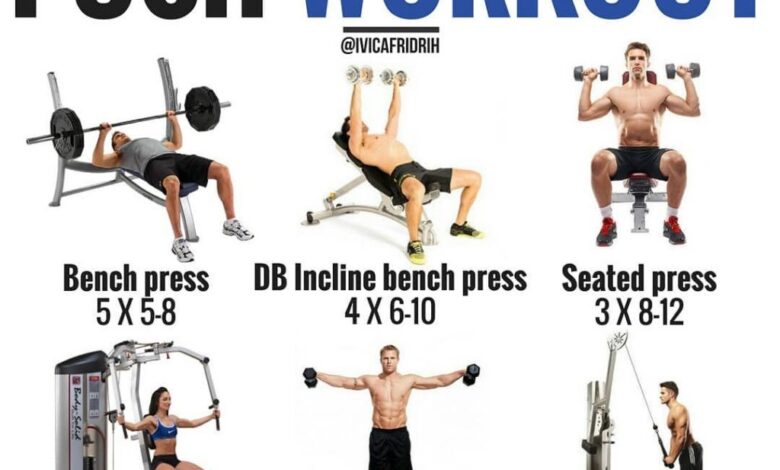
Essential Upper Body Push Workout: Build Strength and Size
Essential upper body push workout: want to sculpt a powerful physique and unlock your upper body potential? This workout is your blueprint to building strength, size, and definition in your chest, shoulders, and triceps. Prepare to push your limits and unleash your inner powerhouse.
This workout focuses on compound exercises that engage multiple muscle groups, maximizing efficiency and promoting overall strength gains. We’ll explore various variations to cater to all fitness levels, ensuring you can tailor the routine to your unique needs and progress at your own pace.
From classic push-ups to challenging bench presses, we’ll cover the essential moves that will transform your upper body.
Upper Body Push Workout: A Guide to Strength and Function
Upper body strength is essential for everyday activities, from carrying groceries to playing with your kids. It also contributes to better posture, injury prevention, and increased confidence. An essential upper body push workout focuses on building strength in the muscles that push, such as your chest, shoulders, and triceps.
This workout will help you develop a strong and functional upper body, improving your overall health and fitness.
Target Muscle Groups
This workout targets the following muscle groups:
- Chest:The chest muscles, or pectoralis major and minor, are responsible for pushing movements like pushing a door open or pressing a weight.
- Shoulders:The shoulder muscles, including the deltoids, are crucial for overhead movements and maintaining shoulder stability.
- Triceps:The triceps are located on the back of your upper arm and are essential for extending your elbow.
Workout Structure
A well-structured workout routine is crucial for maximizing your gains and preventing injuries. This section will Artikel a sample workout routine, including sets, reps, and rest periods for each exercise.
Sample Workout Routine
This routine is designed for beginners and can be adjusted based on your fitness level.
| Exercise | Sets | Reps | Rest |
|---|---|---|---|
| Incline Push-ups | 3 | 8-12 | 60 seconds |
| Dumbbell Bench Press | 3 | 8-12 | 60 seconds |
| Seated Overhead Press | 3 | 8-12 | 60 seconds |
| Triceps Dips (bench) | 3 | 8-12 | 60 seconds |
| Forearm Plank | 3 | 30-60 seconds | 60 seconds |
Exercise Descriptions
Here are detailed descriptions of each exercise, including proper form and technique:
Incline Push-ups
Incline push-ups target the upper chest and front deltoids.
To perform an incline push-up, place your hands shoulder-width apart on an elevated surface, such as a bench or box. Keep your body in a straight line from your head to your heels. Lower your chest towards the surface, bending your elbows at a 45-degree angle. Push back up to the starting position, extending your arms fully.
Dumbbell Bench Press
The dumbbell bench press is a versatile exercise that targets the chest, triceps, and front deltoids.
Lie on a weight bench with your feet flat on the floor. Hold a dumbbell in each hand, with your palms facing each other. Lower the dumbbells towards your chest, keeping your elbows slightly bent. Push the dumbbells back up to the starting position, extending your arms fully.
Seated Overhead Press
The seated overhead press targets the shoulders, triceps, and upper back.
Sit on a bench with your feet flat on the floor. Hold a dumbbell in each hand, with your palms facing each other. Lift the dumbbells up over your head, keeping your elbows slightly bent. Lower the dumbbells back down to the starting position, keeping your elbows slightly bent.
Triceps Dips (bench)
Triceps dips target the triceps, chest, and shoulders.
An essential upper body push workout can be a great way to build strength and sculpt your physique. To get the most out of your fitness journey, consistency is key, and that’s where forming better habits comes in. Check out your 7 day guide to forming better habits for weight loss for tips on incorporating healthy routines into your daily life.
Once you’ve established a solid foundation of healthy habits, you’ll be ready to tackle those upper body push workouts with renewed energy and dedication!
Place your hands shoulder-width apart on a bench. Lower your body down by bending your elbows, keeping your back straight. Push back up to the starting position, extending your arms fully.
Forearm Plank
The forearm plank is a great exercise for strengthening your core, including your abs, obliques, and lower back.
Start in a push-up position, with your forearms on the ground and your body in a straight line from your head to your heels. Hold this position for as long as you can, keeping your core engaged and your body straight.
Exercise Variations and Modifications
The beauty of a push workout lies in its adaptability. You can tailor exercises to your fitness level and preferences, ensuring continuous progress and engagement. This section explores alternative exercises and modifications for each primary movement, allowing you to customize your workout for optimal results.
Alternative Exercises
These alternative exercises provide variations for each primary push movement, offering a broader range of muscle activation and movement patterns.
A solid essential upper body push workout should challenge your chest, shoulders, and triceps. Tracking your progress is key to seeing results, and that’s where the power of data comes in. Learn how to use tracked data to your advantage, from analyzing your performance to setting realistic goals, with this great article on 3 ways to use tracked data to meet your goals.
By using this information, you can optimize your workouts, push harder, and achieve those gains you’ve been striving for in your essential upper body push workout.
- Push-ups:
- Incline Push-ups:Performed with hands elevated on a bench or box, targeting the upper chest more effectively.
- Decline Push-ups:Hands positioned lower than the feet, emphasizing the lower chest and triceps.
- Diamond Push-ups:Hands positioned close together, forming a diamond shape, focusing on triceps strength.
- Close-Grip Push-ups:Hands slightly closer than shoulder-width, engaging the triceps more prominently.
- Wide-Grip Push-ups:Hands wider than shoulder-width, emphasizing chest activation.
- Clap Push-ups:Explosively pushing off the ground to clap hands during the ascent, enhancing power and explosiveness.
- Overhead Press:
- Dumbbell Overhead Press:Utilizes dumbbells for a more controlled and isolated movement, allowing for individual adjustments.
- Barbell Overhead Press:A compound exercise that targets shoulders, upper back, and triceps simultaneously, demanding greater stability.
- Arnold Press:A variation that incorporates an inward rotation of the wrists during the press, engaging more shoulder muscles.
- Bench Press:
- Incline Dumbbell Bench Press:Targets the upper chest muscles, providing a more controlled and adaptable movement.
- Decline Dumbbell Bench Press:Focuses on the lower chest muscles, emphasizing the lower portion of the pecs.
- Close-Grip Bench Press:Emphasizes triceps activation by bringing the hands closer together on the barbell.
- Floor Press:Performed on the floor, eliminating the need for a bench, and targeting the chest muscles with a different angle.
- Dips:
- Parallel Bar Dips:A classic bodyweight exercise targeting triceps, chest, and shoulders, demanding significant strength.
- Assisted Dips:Utilizing a machine or band for support, making the exercise accessible to individuals with lower strength levels.
- Triceps Dips:Emphasizing triceps activation by keeping the elbows close to the body throughout the movement.
Modifications for Different Fitness Levels
Modifications allow individuals of varying fitness levels to participate effectively in the workout.
- Beginner:
- Reduce weight:Start with lighter weights or use resistance bands for a gentler introduction to the exercises.
- Increase repetitions:Focus on performing higher repetitions with lighter weights to build muscle endurance.
- Modify exercises:Utilize modifications like incline push-ups or assisted dips to reduce the difficulty level.
- Intermediate:
- Increase weight:Gradually increase the weight used as strength improves, challenging the muscles further.
- Decrease repetitions:Perform fewer repetitions with heavier weights to focus on building strength and power.
- Introduce variations:Experiment with different exercise variations to stimulate muscle growth and prevent plateaus.
- Advanced:
- Maximize weight:Utilize heavier weights to push beyond previous limits and stimulate muscle hypertrophy.
- Decrease rest periods:Shorten rest intervals between sets to increase metabolic stress and promote growth.
- Incorporate advanced techniques:Explore advanced training techniques like drop sets, supersets, or forced reps to challenge the muscles further.
A solid upper body push workout is essential for building strength and definition, but it’s important to fuel your body properly for optimal results. If you’re looking to increase your carb intake while staying healthy, check out this helpful article: ask the rd how can i increase carbs with healthy options.
With the right nutrition, you’ll be able to power through your push-ups, bench presses, and shoulder presses with more energy and strength.
Adjusting Weight and Reps for Individual Needs
Finding the right weight and rep range is crucial for optimal results.
Weight:Choose a weight that allows you to complete the desired number of repetitions with good form, while feeling challenged by the last few reps.
Reps:The number of repetitions performed in a set influences the training stimulus. Higher reps (12-15) promote muscle endurance, while lower reps (6-8) focus on strength and power.
- Progressive Overload:Gradually increase the weight or reps over time to continually challenge the muscles and promote growth.
- Listen to your body:Pay attention to your body’s feedback. If an exercise feels too heavy or light, adjust the weight accordingly.
Warm-up and Cool-down
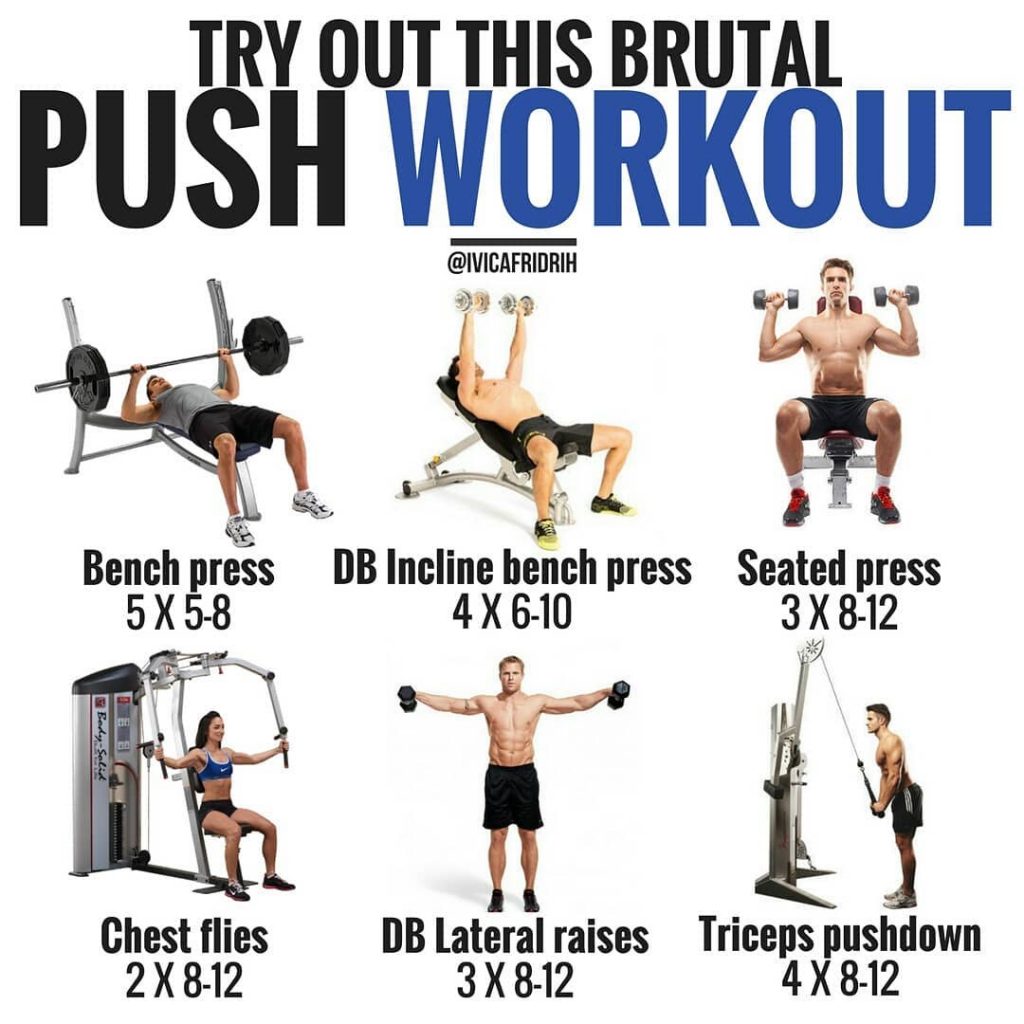
A proper warm-up prepares your body for the demands of your workout, reducing the risk of injury and enhancing performance. Conversely, a cool-down helps your body recover and promotes flexibility.
Warm-up Routine
A dynamic warm-up involves movements that increase your heart rate and prepare your muscles for the workout ahead. This can include light cardio and dynamic stretches.
- Light Cardio:Start with 5 minutes of light cardio, such as jogging in place, jumping jacks, or skipping rope. This will increase your heart rate and blood flow, warming up your muscles.
- Dynamic Stretching:Follow your light cardio with 5-10 minutes of dynamic stretches, focusing on the muscle groups you’ll be working during your workout. Some examples include:
- Arm circles:Slowly circle your arms forward and backward, keeping your shoulders relaxed.
- Leg swings:Swing your legs forward and backward, keeping your core engaged.
- Chest stretches:Interlock your fingers behind your back and lift your arms overhead, keeping your back straight.
- Shoulder rolls:Roll your shoulders forward and backward in a circular motion.
- Cat-cow pose:Start on your hands and knees, then arch your back like a cat, followed by dropping your belly like a cow.
Cool-down Routine
A cool-down routine helps your body gradually return to its resting state and promotes flexibility. It involves static stretches and light cardio.
- Light Cardio:Continue with 5 minutes of light cardio, such as walking or slow jogging. This will help to reduce muscle soreness and promote recovery.
- Static Stretching:Spend 5-10 minutes performing static stretches, holding each stretch for 30 seconds. Some examples include:
- Triceps stretch:Reach one arm across your body and grab your elbow with your opposite hand. Gently pull your elbow towards your chest, feeling the stretch in your triceps.
- Biceps stretch:Extend your arm forward and grab your hand with your opposite hand. Gently pull your hand towards your chest, feeling the stretch in your biceps.
- Shoulder stretch:Interlock your fingers behind your back and lift your arms overhead, keeping your back straight.
- Chest stretch:Place your hands on a wall at shoulder height, step back with one foot, and lean forward, feeling the stretch in your chest.
- Quadriceps stretch:Grab your foot with your hand and pull your heel towards your buttock, feeling the stretch in your quadriceps.
- Hamstring stretch:Sit on the floor with your legs extended. Lean forward from your hips, reaching for your toes, feeling the stretch in your hamstrings.
Nutrition and Recovery
Your upper body push workout demands a lot from your muscles, and giving them the right fuel and rest is crucial for growth and recovery. Proper nutrition plays a vital role in muscle building and repair, while hydration and sleep contribute significantly to overall recovery.
Importance of Nutrition for Muscle Growth and Recovery
Optimizing your diet is crucial for muscle growth and recovery after your upper body push workout. Consuming adequate protein, carbohydrates, and healthy fats provides the necessary building blocks for muscle repair and growth.
- Protein: Protein is essential for muscle protein synthesis, the process of building and repairing muscle tissue. Aim for 1.6-2.2 grams of protein per kilogram of body weight per day. Excellent sources include lean meats, poultry, fish, eggs, dairy products, and plant-based proteins like tofu, beans, and lentils.
- Carbohydrates: Carbohydrates provide energy for your workouts and replenish glycogen stores in your muscles. Choose complex carbohydrates like whole grains, fruits, and vegetables over simple sugars.
- Healthy Fats: Healthy fats, like those found in avocados, nuts, and olive oil, are important for hormone production and cell function. They also help your body absorb essential vitamins and minerals.
The Role of Hydration and Sleep in Muscle Recovery, Essential upper body push workout
Hydration and sleep are often overlooked but are essential for muscle recovery.
- Hydration: Water is crucial for many bodily functions, including muscle recovery. Dehydration can impair muscle function and delay recovery. Aim to drink plenty of water throughout the day, especially before, during, and after your workouts.
- Sleep: During sleep, your body repairs and rebuilds muscle tissue. Aim for 7-9 hours of quality sleep each night.
Tips for Optimizing Nutrition and Recovery
- Consume a balanced meal or snack within 30-60 minutes after your workout: This helps replenish glycogen stores and provide your muscles with the necessary nutrients for repair.
- Prioritize protein intake: Include a good source of protein in each meal and snack. This will help maximize muscle protein synthesis.
- Stay hydrated: Drink water throughout the day, especially during and after your workout.
- Get enough sleep: Aim for 7-9 hours of quality sleep each night to allow your body to recover and rebuild muscle tissue.
- Consider supplements: While a balanced diet should provide all the nutrients you need, some supplements like creatine and glutamine may enhance muscle growth and recovery.
Safety and Injury Prevention: Essential Upper Body Push Workout
While upper body push exercises are excellent for building strength and muscle, it’s crucial to prioritize safety to prevent injuries. This section will delve into common injuries associated with these exercises, offer tips for prevention, and emphasize the importance of listening to your body.
Common Upper Body Push Exercise Injuries
Understanding common injuries associated with upper body push exercises can help you take preventive measures. Some of the most frequent injuries include:
- Rotator Cuff Injuries:These injuries affect the group of muscles and tendons surrounding the shoulder joint, often caused by overuse, improper form, or sudden forceful movements.
- Shoulder Impingement Syndrome:This occurs when tendons and bursa in the shoulder are compressed, leading to pain and inflammation.
- Epicondylitis (Tennis Elbow) and Epitrochlitis (Golfer’s Elbow):These conditions involve inflammation of the tendons around the elbow joint, often caused by repetitive motions or excessive strain.
- Wrist Injuries:Pushing exercises can put stress on the wrists, leading to strains, sprains, or carpal tunnel syndrome.
- Lower Back Pain:Improper form or lifting heavy weights can strain the lower back muscles.
Preventing Injuries
Preventing injuries during upper body push exercises requires a multi-faceted approach:
Proper Form
- Focus on Technique:Prioritize proper form over lifting heavy weights. Use a mirror or have a spotter to ensure correct alignment and movement patterns.
- Control the Movement:Avoid jerking or using momentum. Maintain a controlled pace throughout the exercise, focusing on engaging the target muscles.
- Maintain Neutral Spine:Keep your back straight and avoid arching or rounding your spine.
- Engage Core Muscles:Actively engage your core muscles to stabilize your body and protect your spine.
Gradual Progression
- Start Light:Begin with lighter weights and gradually increase the load as your strength improves.
- Increase Reps or Sets:Instead of immediately increasing weight, focus on increasing the number of repetitions or sets before moving to heavier weights.
- Listen to Your Body:If you feel any pain or discomfort, stop the exercise and consult with a healthcare professional.
Adequate Rest and Recovery
- Rest Between Sets:Allow sufficient rest between sets to allow your muscles to recover and rebuild.
- Recovery Days:Schedule rest days into your training routine to give your body time to repair and adapt.
- Sleep:Adequate sleep is crucial for muscle recovery and overall health.
Listen to Your Body
- Pain is a Signal:Pain is a sign that something is wrong. Don’t ignore it.
- Adjust Your Workout:If you feel pain, reduce the weight, adjust the exercise, or take a break.
- Seek Professional Guidance:If you experience persistent pain, consult with a doctor, physical therapist, or certified personal trainer.
Progress and Results
Tracking your progress and witnessing the results of your hard work is an essential part of any fitness journey. It not only helps you stay motivated but also provides valuable insights into your strength gains and overall fitness improvements.
Tracking Progress and Measuring Results
Tracking your progress helps you assess your improvement and make necessary adjustments to your workout routine. It also allows you to celebrate your achievements and stay motivated. Here are some effective ways to track your progress:
- Record your workouts:Keep a detailed log of your workouts, including the exercises you performed, the weight you lifted, the number of repetitions, and the sets you completed. This provides a comprehensive record of your progress over time.
- Measure your strength:Regularly test your strength by performing specific exercises like bench press, overhead press, and rows. Note down your maximum weight for each exercise and compare it to your previous records to gauge your strength gains.
- Track your body composition:Measure your body fat percentage and muscle mass to assess your overall progress. This can be done through methods like bioelectrical impedance analysis (BIA) or skinfold calipers.
- Take progress photos:Capture photos of yourself at regular intervals to visually track your progress. Compare your earlier photos with your recent ones to see the changes in your physique and muscle definition.
Staying Motivated and Consistent
Staying motivated and consistent with your workout routine can be challenging, but it’s crucial for achieving your fitness goals. Here are some tips to help you stay motivated:
- Set realistic goals:Avoid setting unrealistic goals that are difficult to achieve. Instead, set small, achievable goals that you can gradually build upon. This will help you stay motivated and avoid getting discouraged.
- Find a workout buddy:Having a workout partner can provide motivation, accountability, and support. You can encourage each other, push each other to do better, and make the workout more enjoyable.
- Make it a habit:Treat your workouts like any other important appointment. Schedule them into your calendar and stick to the schedule as much as possible. Consistency is key to building strength and achieving your fitness goals.
- Reward yourself:Celebrate your achievements by rewarding yourself with something you enjoy. This could be anything from a new workout outfit to a relaxing massage.
Adjusting the Workout Plan
As you progress, your body will adapt to the workout routine. It’s essential to adjust your workout plan to continue challenging yourself and promoting further growth.
- Increase weight:As you get stronger, gradually increase the weight you lift for each exercise. This will ensure that you continue to challenge your muscles and stimulate growth.
- Add more sets or reps:If you find that the current weight is becoming too easy, consider adding more sets or repetitions to your workout. This will increase the volume of your workout and challenge your muscles further.
- Introduce new exercises:Challenge your muscles with new exercises that target different muscle groups or variations of the exercises you’re already doing. This will prevent plateaus and promote continued progress.
Ultimate Conclusion
Embrace the challenge, listen to your body, and watch your upper body strength and definition soar. This workout isn’t just about pushing weight; it’s about pushing yourself to become stronger, more confident, and more capable. Remember, consistency is key, so stay dedicated, and you’ll be amazed by the results you achieve.

